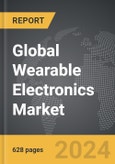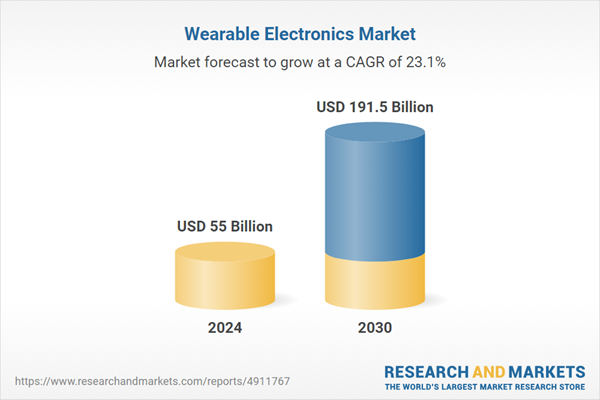The global market for Wearable Electronics was valued at US$55.0 Billion in 2024 and is projected to reach US$191.5 Billion by 2030, growing at a CAGR of 23.1% from 2024 to 2030. This comprehensive report provides an in-depth analysis of market trends, drivers, and forecasts, helping you make informed business decisions. The report includes the most recent global tariff developments and how they impact the Wearable Electronics market.
The innovation within the wearable electronics sector is driven by significant advancements in miniaturization and battery technology. As components become smaller, more powerful, and less energy-intensive, wearable devices have become more practical, efficient, and appealing to consumers. For instance, recent developments in micro-LED technology have allowed displays to be brighter and more energy-efficient, which is crucial for devices that require long battery life within compact designs. Furthermore, improvements in sensor technology have enabled wearables to gather more accurate and diverse data, enhancing their utility in health monitoring and medical diagnostics. These technological advances are coupled with a growing focus on aesthetics and user comfort, leading to devices that are not only functional but also stylish and tailored to individual tastes and needs, thereby broadening their appeal across different segments of consumers.
The growth in the wearable electronics market is driven by several factors, including the increasing consumer focus on health and fitness, the integration of AI and machine learning technologies, and the expansion of IoT applications. As people become more health-conscious, there is a greater demand for devices that can provide real-time insights into personal health metrics and offer proactive health management tools. AI and machine learning enhance the capability of wearables to predict health issues based on data trends, make personalized recommendations, and provide more interactive and responsive user experiences. Additionally, as the IoT ecosystem expands, wearables are becoming essential components for a connected life, enabling users to interact more seamlessly with smart home devices, vehicles, and other digital environments. The market is further propelled by the increasing smartphone penetration worldwide, as these devices often serve as the central hub for managing and processing data collected by wearables. These drivers ensure that the market for wearable electronics continues to expand, reflecting broader technological trends and changing consumer behaviors toward technology integration into daily life.
Segments: Product (Wristwear, Eyewear, Hearables, Bodywear, and Other Products); Component (Memory, Sensor, Display, Connectivity, PCBs, and Other Components); and Application (Consumer Electronics, Healthcare, Enterprise & Industrial, and Other Applications).
Geographic Regions/Countries: World; United States; Canada; Japan; China; Europe (France; Germany; Italy; United Kingdom; and Rest of Europe); Asia-Pacific; Rest of World.
The analysts continuously track trade developments worldwide, drawing insights from leading global economists and over 200 industry and policy institutions, including think tanks, trade organizations, and national economic advisory bodies. This intelligence is integrated into forecasting models to provide timely, data-driven analysis of emerging risks and opportunities.
Global Wearable Electronics Market - Key Trends & Drivers Summarized
Wearable electronics, encompassing devices like fitness trackers, smartwatches, health monitors, and advanced textile-based electronics, have revolutionized how individuals interact with technology and manage their personal health and wellness. These devices integrate advanced computing capabilities and connectivity options into items that can be comfortably worn on the body, providing users continuous access to data about their health metrics, such as heart rate, sleep patterns, and physical activity levels. Beyond health and fitness, wearable electronics extend to virtual reality headsets, augmented reality glasses, and even smart jewelry that syncs with mobile devices for notifications and communication. This integration of technology into personal accessories has not only improved lifestyles but also fostered a new era of digital connectivity, making technology an intimate and indispensable part of everyday life.The innovation within the wearable electronics sector is driven by significant advancements in miniaturization and battery technology. As components become smaller, more powerful, and less energy-intensive, wearable devices have become more practical, efficient, and appealing to consumers. For instance, recent developments in micro-LED technology have allowed displays to be brighter and more energy-efficient, which is crucial for devices that require long battery life within compact designs. Furthermore, improvements in sensor technology have enabled wearables to gather more accurate and diverse data, enhancing their utility in health monitoring and medical diagnostics. These technological advances are coupled with a growing focus on aesthetics and user comfort, leading to devices that are not only functional but also stylish and tailored to individual tastes and needs, thereby broadening their appeal across different segments of consumers.
The growth in the wearable electronics market is driven by several factors, including the increasing consumer focus on health and fitness, the integration of AI and machine learning technologies, and the expansion of IoT applications. As people become more health-conscious, there is a greater demand for devices that can provide real-time insights into personal health metrics and offer proactive health management tools. AI and machine learning enhance the capability of wearables to predict health issues based on data trends, make personalized recommendations, and provide more interactive and responsive user experiences. Additionally, as the IoT ecosystem expands, wearables are becoming essential components for a connected life, enabling users to interact more seamlessly with smart home devices, vehicles, and other digital environments. The market is further propelled by the increasing smartphone penetration worldwide, as these devices often serve as the central hub for managing and processing data collected by wearables. These drivers ensure that the market for wearable electronics continues to expand, reflecting broader technological trends and changing consumer behaviors toward technology integration into daily life.
Report Scope
The report analyzes the Wearable Electronics market, presented in terms of units. The analysis covers the key segments and geographic regions outlined below.Segments: Product (Wristwear, Eyewear, Hearables, Bodywear, and Other Products); Component (Memory, Sensor, Display, Connectivity, PCBs, and Other Components); and Application (Consumer Electronics, Healthcare, Enterprise & Industrial, and Other Applications).
Geographic Regions/Countries: World; United States; Canada; Japan; China; Europe (France; Germany; Italy; United Kingdom; and Rest of Europe); Asia-Pacific; Rest of World.
Key Insights:
- Market Growth: Understand the significant growth trajectory of the Wristwear segment, which is expected to reach US$98.6 Billion by 2030 with a CAGR of a 21.4%. The Eyewear segment is also set to grow at 25.6% CAGR over the analysis period.
- Regional Analysis: Gain insights into the U.S. market, valued at $19.2 Billion in 2024, and China, forecasted to grow at an impressive 25.8% CAGR to reach $19.7 Billion by 2030. Discover growth trends in other key regions, including Japan, Canada, Germany, and the Asia-Pacific.
Why You Should Buy This Report:
- Detailed Market Analysis: Access a thorough analysis of the Global Wearable Electronics Market, covering all major geographic regions and market segments.
- Competitive Insights: Get an overview of the competitive landscape, including the market presence of major players across different geographies.
- Future Trends and Drivers: Understand the key trends and drivers shaping the future of the Global Wearable Electronics Market.
- Actionable Insights: Benefit from actionable insights that can help you identify new revenue opportunities and make strategic business decisions.
Key Questions Answered:
- How is the Global Wearable Electronics Market expected to evolve by 2030?
- What are the main drivers and restraints affecting the market?
- Which market segments will grow the most over the forecast period?
- How will market shares for different regions and segments change by 2030?
- Who are the leading players in the market, and what are their prospects?
Report Features:
- Comprehensive Market Data: Independent analysis of annual sales and market forecasts in US$ Million from 2024 to 2030.
- In-Depth Regional Analysis: Detailed insights into key markets, including the U.S., China, Japan, Canada, Europe, Asia-Pacific, Latin America, Middle East, and Africa.
- Company Profiles: Coverage of players such as ASUSTeK Computer, Inc., Fitbit, Inc., Nike, Inc., Google, Inc., Apple, Inc. and more.
- Complimentary Updates: Receive free report updates for one year to keep you informed of the latest market developments.
Some of the 133 companies featured in this Wearable Electronics market report include:
- ASUSTeK Computer, Inc.
- Fitbit, Inc.
- Nike, Inc.
- Google, Inc.
- Apple, Inc.
- Samsung Electronics Co. Ltd.
- Garmin Ltd.
- Sensoria Inc.
- LG Electronics
- Scosche industries
Tariff Impact Analysis: Key Insights for 2025
Global tariff negotiations across 180+ countries are reshaping supply chains, costs, and competitiveness. This report reflects the latest developments as of April 2025 and incorporates forward-looking insights into the market outlook.The analysts continuously track trade developments worldwide, drawing insights from leading global economists and over 200 industry and policy institutions, including think tanks, trade organizations, and national economic advisory bodies. This intelligence is integrated into forecasting models to provide timely, data-driven analysis of emerging risks and opportunities.
What’s Included in This Edition:
- Tariff-adjusted market forecasts by region and segment
- Analysis of cost and supply chain implications by sourcing and trade exposure
- Strategic insights into geographic shifts
Buyers receive a free July 2025 update with:
- Finalized tariff impacts and new trade agreement effects
- Updated projections reflecting global sourcing and cost shifts
- Expanded country-specific coverage across the industry
Table of Contents
I. METHODOLOGYII. EXECUTIVE SUMMARYIII. MARKET ANALYSISREST OF WORLDIV. COMPETITION
1. MARKET OVERVIEW
2. FOCUS ON SELECT PLAYERS
3. MARKET TRENDS & DRIVERS
4. GLOBAL MARKET PERSPECTIVE
UNITED STATES
CANADA
JAPAN
CHINA
EUROPE
FRANCE
GERMANY
ITALY
UNITED KINGDOM
REST OF EUROPE
ASIA-PACIFIC
Companies Mentioned (Partial List)
A selection of companies mentioned in this report includes, but is not limited to:
- ASUSTeK Computer, Inc.
- Fitbit, Inc.
- Nike, Inc.
- Google, Inc.
- Apple, Inc.
- Samsung Electronics Co. Ltd.
- Garmin Ltd.
- Sensoria Inc.
- LG Electronics
- Scosche industries
Table Information
| Report Attribute | Details |
|---|---|
| No. of Pages | 628 |
| Published | April 2025 |
| Forecast Period | 2024 - 2030 |
| Estimated Market Value ( USD | $ 55 Billion |
| Forecasted Market Value ( USD | $ 191.5 Billion |
| Compound Annual Growth Rate | 23.1% |
| Regions Covered | Global |









